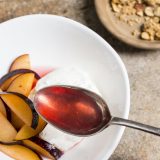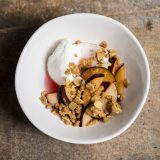Poached plum recipes tend to follow a singular trajectory. Simmer liquid, sugar and flavorings; submerge pitted plum halves; cook until tender.
It’s point-and-shoot simple, which we liked. But when we started experimenting with recipes, we found the margin for error—particularly for overcooking the plums—to be unforgivably narrow.
Our solution: Macerate, don’t poach. Macerating is the produce world’s answer to marinating, a method that skips the cooking and preserves the freshness of the fruit.
We liked British chef Andrew MacKenzie’s take on this. MacKenzie, of The Restaurant at Drakes in Brighton, England, slices plums and pours hot syrup over them, then lets them steep. The slices absorb the flavorful syrup and just barely soften, with no risk of turning mushy.
For our version, we discarded syrups made with water (too bland) and tea (too strong) and tawny port (too heavy). But we liked the acidity of the wine, which balanced the sugar and heightened the flavor of the plums. Both sauvignon blanc and rosé offered light acidity and a fruitiness that complemented the plums.
But the syrup was still missing something. We considered various flavorings but settled on 2 teaspoons of black peppercorns, which added a mellow bite that further balanced the sweetness of the syrup and fruit. Lemon zest added a fresh note.
The plums were terrific over ice cream or Greek yogurt (plain or spiced, see sidebar), but the combination needed contrast. The answer was to make a simple streusel mixed with almonds. We didn’t want to subject our fresh plums to the heat of the oven, so we baked the crunchy topping separately and simply spooned it over the fruit and yogurt.
To tie the streusel to the syrup, we added more black pepper. Together, it was a more mature take on a treat too often cloying and mushy.





